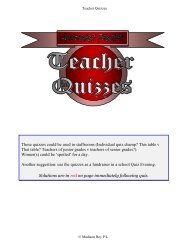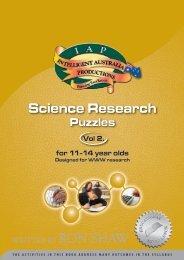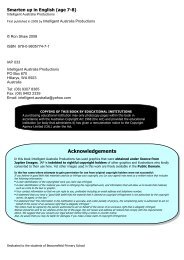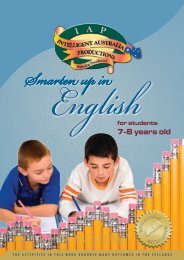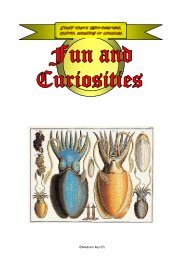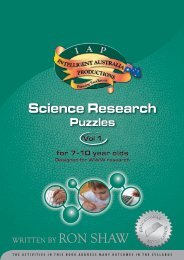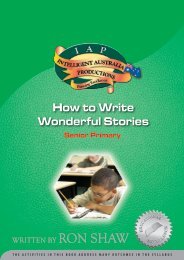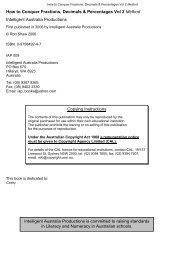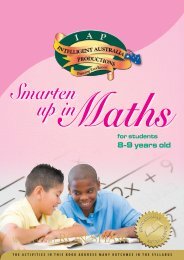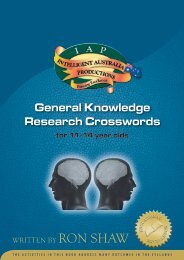ANZAC Intelligent Australia Productions Copying Instructions ...
ANZAC Intelligent Australia Productions Copying Instructions ...
ANZAC Intelligent Australia Productions Copying Instructions ...
- No tags were found...
You also want an ePaper? Increase the reach of your titles
YUMPU automatically turns print PDFs into web optimized ePapers that Google loves.
During World War 1, the wives, mothers and girlfriends of the <strong>Australia</strong>n soldiers were concerned about the nutritionalvalue of the food being supplied to their men. There was a problem. Any food they sent to the fighting men had to becarried in the ships of the Merchant Navy. Most of these were lucky to maintain a speed of ten knots (18.5 kilometresper hour). Most had no refrigerated facilities, so any food sent had to be able to remain edible for periods in excess oftwo months. A group of women came up with the answer - a biscuit with all the nutritional value possible. The basis wasa Scottish recipe using rolled oats. These oats were used extensively in Scotland, especially for a heavy porridge thathelped counteract the extremely cold climate.The ingredients they used were: rolled oats, sugar, plain flour, coconut, butter, golden syrup or treacle, bicarbonate ofsoda and boiling water. All these items did not readily spoil. At first the biscuits were called Soldiers’ Biscuits, but afterthe landing on Gallipoli, they were renamed <strong>ANZAC</strong> Biscuits.A point of interest is the lack of eggs to bind the <strong>ANZAC</strong> biscuit mixture together. Because of the war, many of thepoultry farmers had joined the services, thus eggs were scarce. The binding agent for the biscuits was golden syrup ortreacle. Eggs that were sent long distances were coated with a product called ke peg (like Vaseline) then packed inairtight containers filled with sand to cushion the eggs and keep out the air.As the war drew on, many groups like the CWA (Country Women’s Association), church groups, schools and otherwomen’s organisations devoted a great deal of time to the making of <strong>ANZAC</strong> biscuits. To ensure that the biscuitsremained crisp, they were packed in used tins, such as Billy Tea tins. You can see some of these tins appearing in yoursupermarket as exact replicas of the ones of earlier years. Look around. The tins were airtight, thus no moisture in theair was able to soak into the biscuits and make them soft. Most people would agree there is nothing worse than a softbiscuit.During World War 2, with refrigeration in so many Merchant Navy Ships, the biscuits were not made to any great extent.It was now possible to send a greater variety of food, like fruit cake.<strong>ANZAC</strong> biscuits are still made today. They can also be purchased from supermarkets and specialty biscuit shops. Around<strong>ANZAC</strong> Day, these biscuits are also often used by veterans’ organisations to raise funds for the care and welfare of agedwar veterans.- Cut out or copy -Anzac Biscuits RecipeMelt & Mix MethodIngredients: 125gm Butter 2 tablespoons Golden Syrup 1 Cup Coconut 2 teaspoons Bicarbonate Soda 1 Cup Flour 1 Cup Sugar 1 Cup Rolled Oats 2 tablespoons Boiling WaterMethod:1. Melt butter and Golden Syrup.2. Dissolve soda in boiling water.3. Add liquids to dry ingredients.4. Place in teaspoon-size lumps on agreased baking tray5. Bake at 160 degrees Celcius for 18 -20 mins.6. Cool on cake cooler.SketchIn this space draw a picture of some<strong>ANZAC</strong>s enjoying a snack of <strong>ANZAC</strong>biscuits with a cup of tea.Writing ActivityOn a separate piece of paper or in your bookwrite a summary of the passage at the top (120-200 words).© <strong>Intelligent</strong> <strong>Australia</strong> <strong>Productions</strong> 15




